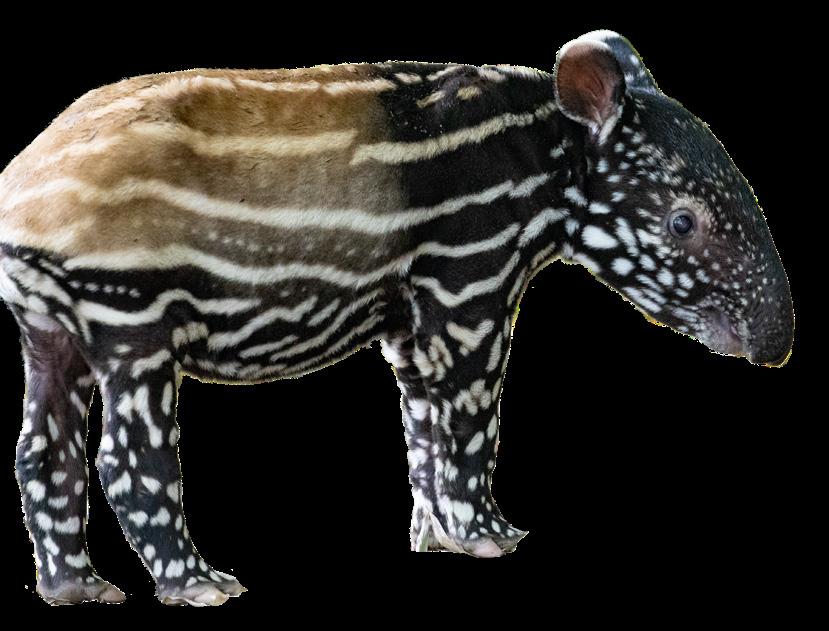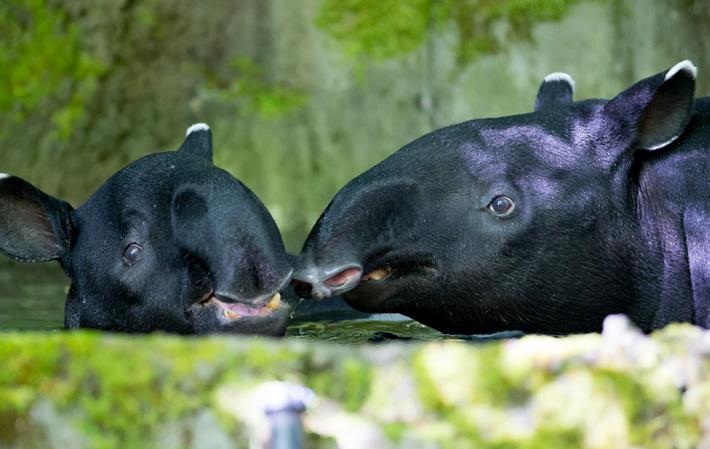
2 minute read
Welcome Baby Tapir
With spots and stripes to stay hidden in the bamboo and reeds, a baby tapir looks a lot like a watermelon when it's born. We'll watch our #SeattleWatermelon grow together.
WELCOME
TAPIR BABY
Click image to see adorable footage of the new mom and baby!

The #SeattleWatermelon has arrived. On June 10 at approximately 9:30 p.m., our Malayan tapir mama, Ulan, gave birth to her first baby, a girl, with father Bintang. We are in love.
The average weight for calves at birth is 22 pounds, and Ulan's baby was 18 pounds. Calves are born with their eyes open and can stand within one or two hours after birth— and as you can see from these photos—baby tapirs hit their adorable watermelon benchmark right away!
We are so excited to watch the tapir calf explore her yard, which we did our best to tapir baby-proof! We can’t wait to share her (and all her watermelon-like spots and stripes) with our community this summer.
Visit zoo.org/tapir to keep up to date on the baby’s milestones, and check out our tapir activity packets and extra special #SeattleWatermelon downloads.
Calling all artists!
The #SeattleWatermelon summer coloring contest starts now! See page 28
TAPIR TRIVIA
How much do you really know about tapirs? Click the button to test your knowledge with Tapir Trivia!
Tapirs are among the most primitive large mammals in the world, changing little in appearance for millions of years. This prehistoric-looking animal looks like a massive pig with a long snout. Because they have an odd number of toes (four toes on each front foot, three on each back foot), their closest relatives are horses and rhinos.
A newborn tapir looks like a watermelon on legs due to its reddish-brown coat dappled with white and cream-colored spots and stripes. This color pattern works wonders as camouflage in bamboo or reed jungles. The striped pattern begins to fade after a few months and the calf begins to look like a miniature adult at about 5 to 8 months old.
Tapirs are great, fast swimmers. They often use their trunk-like snout like a snorkel!
Malayan tapirs are the largest of the four species of tapirs, but all tapirs are highly endangered. The Malayan tapir ranges in Thailand, Peninsular Malaysia, Sumatra and Myanmar. The other three species are found in Central and South America.
PROTECTING TAPIR TERRITORY
Woodland Park Zoo partners with conservation projects in Peninsular Malaysia and Sumatra, where tapirs are found. By investing in land protection and habitat management, the work the zoo is doing helps to protect tapirs in their current habitats. “One of the greatest threats to tapirs is loss of habitat. By protecting land for tigers, orangutans and hornbills, the zoo is also protecting land for tapirs,” says Woodland Park Zoo Vice President of Conservation Initiatives Peter Zahler. “Everyone can join our efforts too. By making informed purchasing decisions and buying products with certified sustainable palm oil, you’re protecting tapirs and the forests they live in.” More information at zoo.org/palmoil.






